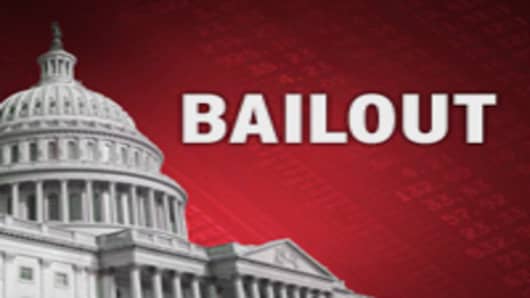“My conclusion is that they don't have a long-term strategy, and they're bouncing along from crisis to crisis,” said former FDIC Chairman William Isaac.
Critics in and out of government say the misguided decision to use TARP money for the auto bailout is an abuse of the program and will have negative consequences.
“Using TARP funds to bail out failing companies is incredibly risky and poor public policy, and was not the designated intention of the program when Congress approved it,” said Rep. Jeb Hensarling, a Texas Republican, who voted against the $700 billion TARP fund and is now one of four members of Congress’ oversight committee.
Hensarling and others were quick to add that the auto bailout would lead to similar aid to other sectors.
“This is classic pork," said Tom Schatz, president of Citizens Against Government Waste. “There's going to be a long list, saying, ‘Now help us.’ They’re already lining up.”
Even critics of the TARP, which was rushed into law in the aftermath of theLehman Brothersbankruptcy filing in mid-September, had been steadfast in saying if money has to be spent at all it should be used in efforts aimed at directly stabilizing the financial system.
Until the auto bailout, all $335 billion of the $350 billion authorized thus far had been committed to financial institutions, from commercial banks like Citigroup to insurers such as AIG or one-time investment banks likeGoldman Sachs.
“Congress created the TARP not to bail out manufacturing companies but to fix the financial system,” says Isaac. “Regardless of the language, it is clear what the intention was. This is a matter of process. I am deeply troubled."
Paulson, until recently, was thought to agree with that strict interpretation, but was apparently persuaded otherwise by President Bush after Senate Republicans sunk stand-alone legislation backed by Congressional Democrats.
If the auto bailout was troubling, Paulson’s latest policy surprise was confusing.
The Treasury Secretary has changed his mind on the issue more than once. In addition, Democrats in Congress, unhappy over Paulson’s strategy, recently told him they’d reject a request for additional funding, unless they felt like he was doing more to aid housing, particularly in terms of mortgage lending and foreclosure forbearance.
As recently as Wednesday, President-elect Barack Obama seemed to suggest that Paulson wasn’t on the verge of asking for money, saying his team been "in conversations" with the Treasury, but implied a decision was not being discussed.
"At the point they give us some signal this is necessary, then we would evaluate it," added Obama.
But in a statement Friday, Paulson said: “It is clear…that Congress will need to release the remainder of the TARP to support financial market stability.”
Paulson’s decision to seek funding also caused some debate about the current condition of the financial system, which most agree has been stabilized—even if economic activity is contracting swiftly, and the timing of the request.
“It is clear, however that Congress will need to release the remainder of the TARP to support financial market stability,” the Treasury Secretary said in a statement.
“I don't understand why we need another $350 billion," said Isaac.
“Additional $350 billion in TARP funds needs to be approved now," said Brain Bethune, chief US economist at Global Insight. "We are still in the most treacherous phase of the business cycle, and it would be foolish to leave the Treasury Secretary with no arrows in his quiver."
Though Paulson’s statement also said he would “discuss that process with the congressional leadership and the president-elect's transition team in the near future," approval any time soon seems unlikely, from either the lame duck Congress or the one assuming office in early January.
The Congressional oversight panel will be releasing two key reports next month. The first, due Jan. 9, will be an analysis of the program, while the second, scheduled for January 20, the day of the President’s inauguration, will offer recommendation on regulatory reforms.
The mechanics of the approval process also suggest the same. By law, the Congress has 15 days to decide on an official request. Technically, it has to disapprove, or reject, the request for funds. The president, however, can veto that decision.
There’s also the matter of Paulson’s designated replacement, New York Fed chief Timothy Geithner, whose Senate confirmation, once he’s been officially nominated by the new president, would presumably be swift and sure.
Some observers say Paulson’s move is partly intended to keep the markets calm and show he is reaching out to Congressional Democrats and the Obama team about incorporating their strategic agenda. Getting the ball roll rolling on the next installment is prudent, they say.
“The TARP money is beginning to work its way through the system,” says Scott Talbott, senior vice president of government affairs for The Financial Services Roundtable. “The big X-factor is the economy.”



